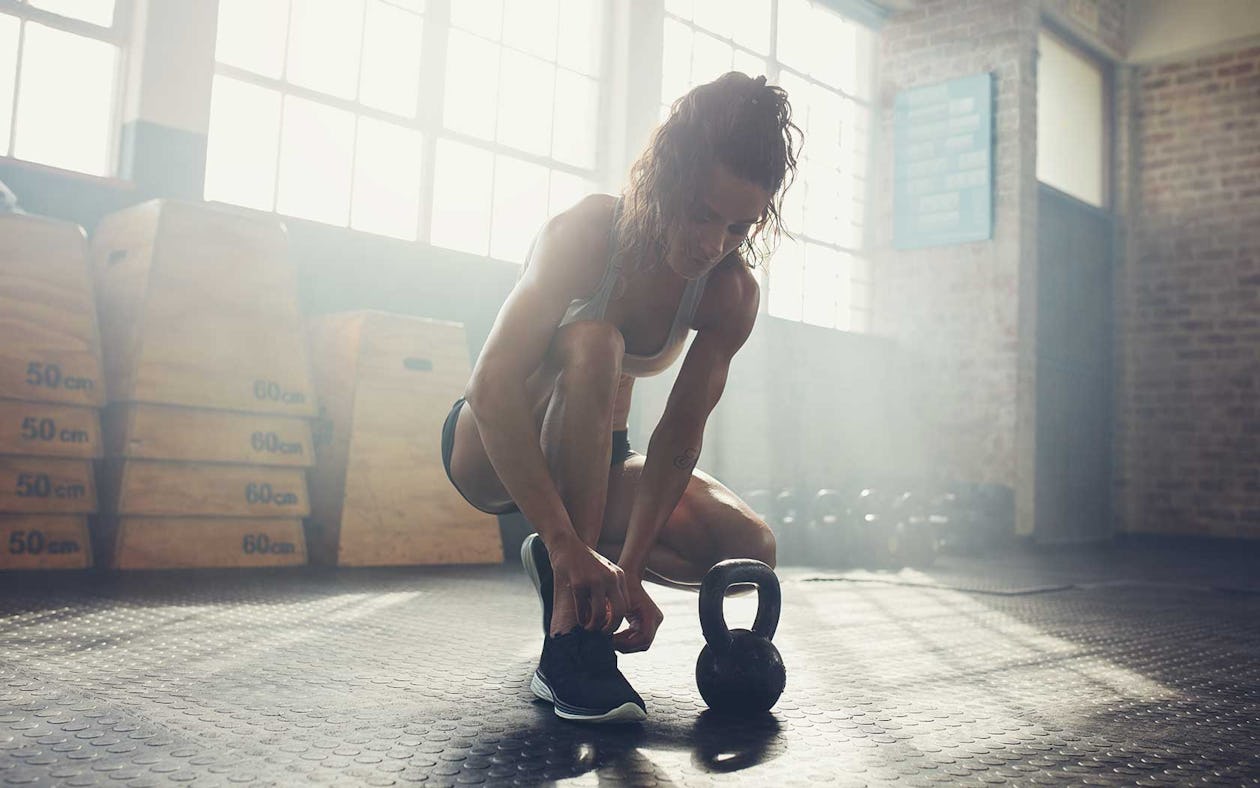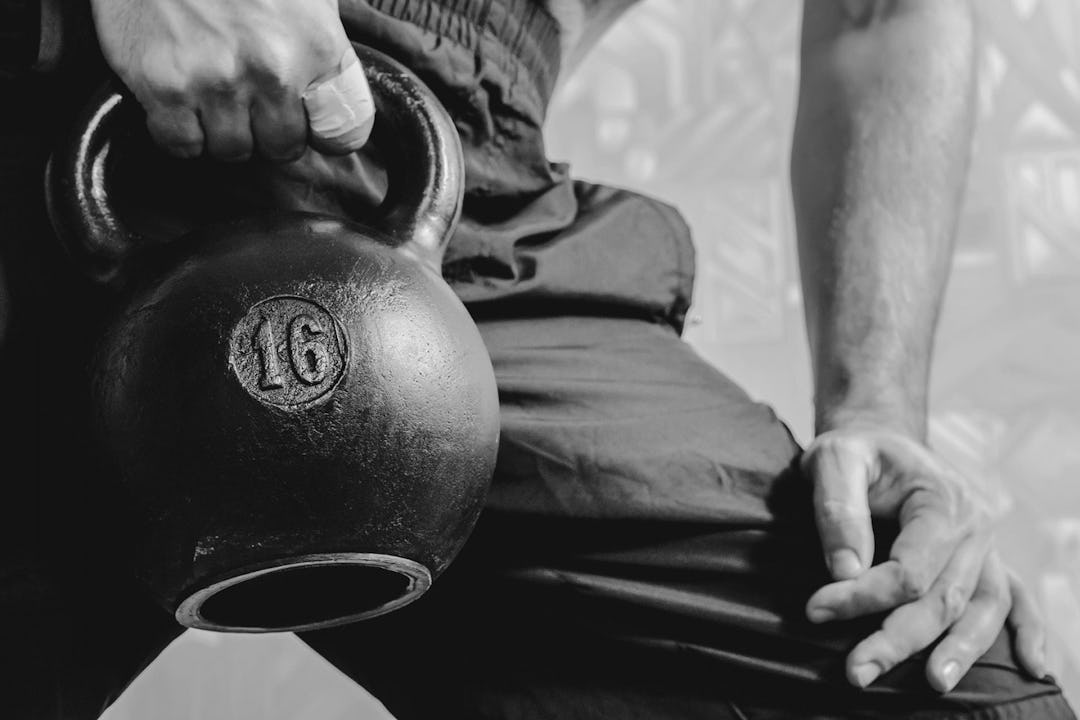We live in a world of infinite knowledge, yet we rarely stop to think about the dangers of such innovation. Technology has given us the ability to traverse oceans with the blink of an eye.
There are a million and one ways to use a kettlebell.
Well, maybe not that many, but in this day and age of strength and conditioning the kettlebell is turning into a standard training tool among coaches and trainees.
With so much information (and misinformation) out there regarding the bell, it’s easy to get lost.
For those just starting out and even those who have been around the block, this quick guide will help you on your path.
Here are five do’s and don’ts for your kettlebell that will keep you safe while seeing incredible gains.
The 5 Don’ts for Kettlebell Benefits

Let’s get these out of the way. In my experience, over the years of using kettlebells, these five points are what limits people from getting the most out the kettlebell.
1. Do Not Take It To The Extreme
Without fail, if something is good there’s a few people out there who think a hell of a lot more must be better. If a swing is good, then let’s take it higher. If the snatch is good, then let’s do it for an hour.
Unless you plan on competing in kettlebell sport, there’s no reason to take a kettlebell movement to the extreme. At best you’ll get burnt out, and at worst you’ll develop an injury. Balance is key. That applies to just about everything in life, too.
If you’re new to the kettlebell and want to jump in with both feet, three full body workouts hitting each movement pattern per week is plenty.
2. Do Not Go Too Light
The conventional gyms and department stores of the world would have you believe that a 10lb kettlebell is all a man needs and a 5lb is plenty for a woman.
Well, my friend, I hate to burst your kettle-bubble, but if you want to see any benefits from the bell you need to challenge yourself.
Of course, we all have to start somewhere and maybe that’s the appropriate weight for you. 99% of the time (a statistic I just made up to prove a point but is still going to be high) trainees go too light. If you’re one of those people, it’s ok.
There’s still hope. There’s no set standard per se as each person is different, but here’s a good guide for non-injured, healthy men and women:
Women: 4kg-12kg
Men: 12kg-20kg
If you’re relatively strong and fit aim towards the higher end the spectrum. If weights just ain’t your thing then go lower.
There will be outliers and even if you can deadlift a 40kg it’s best to use a kettlebell that you can do many movements with as opposed to just one or two to reap the most benefits.
3. Do Not Go Too Heavy
On the flip side going too heavy isn’t going to help you either. By flexing your ego, you’ll do more harm than good. Just because you saw it online or in a certain “games” doesn’t mean you’re ready for it.
Challenging yourself is important, but if you’re breaking form for the purposes of lifting a certain weight, then the potential harm outweighs any good could be doing.
Most injuries happen from the structural breakdown of either fatigue or load. Heavyweight is essential for building strength as long as you stay within your abilities. It’s easy to have a goal of pressing or swinging heavier and heavier weight and to get a bit overzealous.
Even if you’re using a weight, you can handle for a particular rep range stop the set as soon as form deteriorates and even better yet a set or two before that.
[See above weight guide]4. Do Not Exceed Your Abilities
Just because you want to do something doesn’t mean you’re ready to do something. Will is important, but the ability is crucial.
If I had a nickel for each time I’ve seen someone attempting a technical move like the snatch at a conventional gym with zero knowledge of the movement outside of watching a video I’d be a rich man.
Finding a reputable coach in your area or absorbing instructional videos will do your body good. Social media can be a dangerous place if you’re new to the kettlebell world. Juggling, intense movements, and programs with a ton of volume can look enticing, but if you’re not ready for it take a step back.
Assess where you are with your range of motion on any particular movement pattern. Knowing where you are will give you valuable insight as to where to go. Check out the Durability channel on Onnit Academy On Demand to work through tight areas and open up new movements.
5. Do Not Think The Kettlebell Is Just For Cardio
This is most prolific with strength guys and gym rats. Compared to a 500-pound deadlift even the heaviest kettlebell pales in comparison. Of course, it would be viewed as a cardio tool. Do some ballistic work at the end of your workout and call it a day, right?
Well, my friend, you’ll be missing out on the strength-gaining effects of a powerful kettlebell routine. Double kettlebell work, heavy one arm swings, bent presses, goblet squats, and incredible flows will do far more than get your heart pumping. It comes down to awareness of what’s possible.
A powerful routine that will build incredible strength AND conditioning is utilizing the kettlebell (or a few) for a strength-geared circuit. Pick 3-5 movements with a weight that would be a 5-8 RM per movement. Perform each movement for 5 reps resting a minute between exercises.
For example, you can perform a press, goblet squat, renegade row, and one arm swing. Another powerful way to incorporate your bell into a strength session is utilizing a movement for an OTM (on the minute) style session.
This gives you plenty of volumes while keeping reps low. A favorite of mine is the double clean and front squat for sets of 3-6 for 8-12 sets. This gives you PLENTY of room for growth since you can’t change the weights easily.
Now that we got through that here are the Do’s to make the most of your kettlebell training.
The 5 Do’s for Kettlebell Benefits

1. Do Use The Kettlebell To Help Build Weaknesses
Weaknesses. We’ve all got ’em and like to hold on to them for dear life. Some of them become a cop out to attempting tougher movements. The bell can help you get rid of quite a few of those stubborn, sticking points that are holding you back.
Between get-ups, arm bars, windmills and sots presses kettlebell deliver amazing strength, but also incredible mobility from your hips to your shoulders and everything in between.
For years I’ve been telling potential clients “one of the best things about the kettlebell is it gets your comfortable in uncomfortable positions.” This is powerful for building injury-proof athletes and clients.
You can incorporate challenging movements as a warm up or what I do is pick the toughest ones based on my body’s abilities and spend a whole session playing with them.
For example, I’ll incorporate a longer mobility warm up and then hit multiple sets (never to failure) of sots presses and deep goblet squats using lighter weights. While these sessions aren’t the most taxing because of the weight or intensity, they are challenging.
Even if you don’t use them with challenging movements just by adding one of the most basic movements (the swing), you’ll increase hamstring flexibility which leads to a more mobile, healthy. Because of the position of the kettlebell even simply pressing it will pull your arm back a bit further stretching your lats and opening up your shoulders a hair more.
2. Do Use Them To Build a Stronger Backside
What does a stronger backside translate to? Just about everything from jumping higher, running faster, kicking harder and better posture. Your glutes and hamstrings are your power source for building hip speed and explosive strength.
Every muscle in your posterior chain will be enhanced with ballistic kettlebell movements. This is what separates them from dumbbells. Sure you can perform dumbbell clean, and presses, squats, and rows, but high rep ballistic dumbbell work isn’t as easy to do.
What builds the backside is performing ballistic work with a hinge (bending at the hips) thus putting more force on the backside.
The cure? Swings (or a variation of them) performed a minimum of three times a week. This can be alternated with heavy and lighter weights and aiming for 50-200 reps (not necessarily at once).
Sets can be broken down and performed ladder-style, on the minute, or pair them with a calisthenics move like pushups for a more robust session.
3. Do Use Kettlebells To Build An Iron Grip
A strong grip is more useful than the mainstream fitness world gives it credit. While admittedly not as sexy as six pack abs it’s not just for arm-wrestlers and cattle ranchers.
The off-center placement of the bell gives the kettlebell an advantage over other tools as it forces you to keep a flexed forearm while in the rack and overhead position. Combine that with kettlebell flows, juggling, and ballistic movements to strengthen your grip from every angle.
For now, try some simple complexes and circuits where you don’t put the weight down. This will breathe life into your grip tremendously if done with adequate weight. Aim for circuits that last at least 60 seconds with a weight you can handle without putting down.
Eventually, you can try tougher routines and juggling complexes to unleash the power of the bell.
4. Do Use Kettlebells To Train In Different Planes
Most of strength training is done with trunk flexion and extension with the occasional rotational movement medicine ball throw. The beauty of the bell is the ability to transition from movement to movement seamlessly which includes movements that take you out of the sagittal plane.
Squats and deadlifts are awesome, but when you combine powerful movements with the likes of rotational swings, lateral punches, and 360 snatches you’ll build strength from a multitude of angles.
Strength in motion (what we’ve dubbed the outside the box thinking and kettlebell flowing) is almost meditative. There are no rules. There are no sets and reps. You just move, and this allows you to explore different ranges of motion, planes, and movement patterns.
Set the timer for 2 minutes using a weight you can handle through just about every movement. From there combine movements, incorporate rotational work, and just play with it.
5. Do Use Kettlebells To Simplify Your Training Life
If you’re a coach or group class leader kettlebells are fantastic to lead clients through a plethora of movements that will deliver strength and conditioning in record time. If you’re a solo practitioner nothing beats the simplicity of one or two bells and some fresh air.
It’s easy to get caught up in the “more is better” mentality when it comes to gym equipment at conventional locations. Racks, and dumbbells, cable machines, and ab stations and the list goes on.
A few kettlebells allow you to add dynamic movements to your home routine of calisthenics allowing you to simplify. A break from in-depth, percentage-driven routines can be a nice change of pace.
Some simple complexes and movements can help you continue on your strength quest without skipping a beat and minus the tons of equipment and weight needed.
An easy way is to limit your tools to a kettlebell and club or mace, a suspension trainer and your body to build an high-functioning physique without all the fluff.
For more in-depth kettlebell work check out the Kettlebell Channel on Onnit Academy On Demand that will take you through full programs and instructional videos.
This will help you take your kettlebell abilities to the next level and help you unlock your imagination for some fantastic, out of the box strength and conditioning sessions.

)





